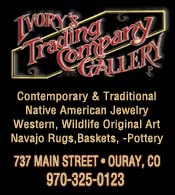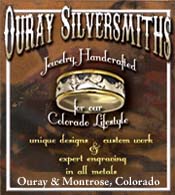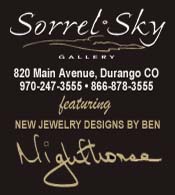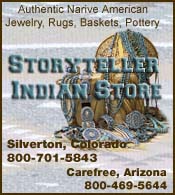handcrafted western jewelry
 Story by Kathryn R. Burke
Story by Kathryn R. Burke
All content © San Juan Publishing Group, Inc, All rights reserved.
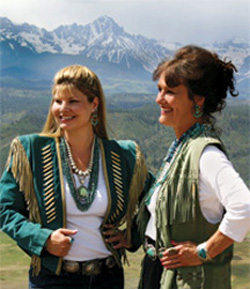 [Colorado and Arizona] Discreet daytime diamonds, a delicate gold chain, or maybe a collar of emeralds
[Colorado and Arizona] Discreet daytime diamonds, a delicate gold chain, or maybe a collar of emeralds
adorning a ball gown—these all have a time and place. Like, maybe where tossing tea in the harbor harbored
a revolution. But in Colorado, the land of towering mountains and vast blue sky, and Arizona with delicate desert hues contrasted with vivid, colorful sunsets, it’s definitely OK to go large! To layer. To add a couple more pieces
and know you can get away with it, whether you are dressed down in jeans or over the top in a killer cocktail
dress.
Whenever, wherever, and however you wear it, western jewelry is just so much fun! And, it’s so much a part of our geologic and cultural western heritage. After all, it’s the down-to-earth part of where we live: rock and metal. You can’t get much more basic than that.
INDIANS
When it comes to big, nobody does big better than Navajo artist Tommy Jackson. See image above, left.) Well known for his use of stunning stones coupled with intricate silverwork, Tommy’s specialty, as he puts it, is “good old American turquoise, the kind where the stone speaks for itself.” His newest pieces feature standbys like Bisbee, Royston, #8 Spiderweb and most recently, dark and light green turquoise from the Broken Arrow mine in Nevada. Teamed up with fellow Navajo silversmith, Aaron Anderson, whose specialty is tuffa silver casting, Tommy’s work can be found in Ouray at Ivory’s Trading Company & Gallery, Ouray, Colo., Storyteller Indian Store, Silverton, Colo. and Carefree, Ariz, and A Shared Blanket, Durango, Colo.
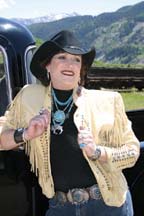 Margaret and David Romero carry an outstanding collection of Indian* jewelry in their two Storyteller Indian Stores, one in Silverton, Colorado (open May – October) and the other in Carefree, Ariz. (open year round). Both stores feature pieces in traditonal and contemporary design, some of the latter done by (Silverton) local artist, Little Elk, and Margaret herself. Margaret, pictured left, is wearing one of Little Elk’s necklaces.
Margaret and David Romero carry an outstanding collection of Indian* jewelry in their two Storyteller Indian Stores, one in Silverton, Colorado (open May – October) and the other in Carefree, Ariz. (open year round). Both stores feature pieces in traditonal and contemporary design, some of the latter done by (Silverton) local artist, Little Elk, and Margaret herself. Margaret, pictured left, is wearing one of Little Elk’s necklaces.
With stores in Silverton, Colo. and Mesa, Ariz. fourth generation trader Debra Ortega offers an incredible selection of Native American jewelry including work by Navajo artists Michael and Michelle Perry and Mary and Evertt Teller, and Zuni artists Nancy and Dennis Edaake and Effie Calavaza.
A visit to Sandy and John Ivory’s Ivory Trading Company and Gallery, Ouray, Colorado is a special treat. Both are avid collectors of western jewerly and memorabillia. Born and bread westerners—Sandy’s Texas accent still lingers and John, a rancher and cattleman, won a few rodeo buckles before settling down into ranching, and now trading in western goods. point to carry an outstanding inventory of fine contemporary and traditional Native American jewelry. Here you will find many custom pieces by top designers such as Tommy Jackson, Kee Joe Benally, Rocki Gorman, and B.G. Mudd, as well as more affordable lines. The Ivory’s gallery has a well-earned reputation for their jewelry and fine Navajo rugs, and the gallery carries an impressive selection.
COWGIRLS
While Native American jewelry, especially designs in turquoise and silver, is generally characteristic of the American Southwest look, it isn’t the only style in the retail showcase…or the jeweler’s bench. Going “western” doesn’t necessarily mean going with Indian jewelry.
Melanie Kline and her son Josh Kline, Ouray Silversmiths, have created a distinctive style of the old west in material and unique design. Calling it the “sassy cowgirl look,” they use clever combinations that are all their own. Pearls and bullets for earrings. A tangle of silver aspen leaves holding a piece of petrified wood pendant laced with opal. Copper sandwiched in silver and constructed to let the “leathery-looking” burnished metal shine through on a wrist cuff.
A silver ring or bracelet fabricated to look like a tiny corral, complete with horses, fences, and miniscule gold ropes. Trophy buckles, wrist cuffs, earrings and earring jackets, necklaces, money clips—all of it with the distinctive style of the old west in material and unique design without the “Native American” look so characteristic of the jewelry of the American Southwest. (Melanie’s granddad was an Orthodox cowboy from Thornton, Colo. who mastered the impossible feat of keeping kosher on the range!)
Melanie is world-renowned for her nearly-priceless Judaica. She’s made designs for heads of state, so designing for Colorado cowgirls is a relief and a treat.
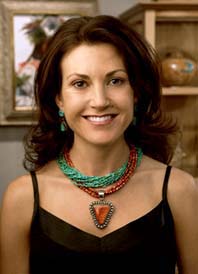 COMBINING THE BEST OF BOTH
COMBINING THE BEST OF BOTH
Sorrel Sky Gallery, Durango, offers the best of both worlds—both contemporary and traditional design by Native and non-Native artists. Shown right worn by gallery owner Shanan Campbell Wells, the work of Artie Yellowhorse (detail, image top second from right) is typified by her intricate hand-made silver beads and contemporary design. For Artie, whose children, grandchildren, nieces, and nephews are all involved, jewelry design is a family affair and she’s proud of keeping the tradition alive.
As an artist (and statesman), Ben Nighthorse Campbell stands alone. (See image, top right.) “When someone buys his jewelry, they are participating in a creative transfer,” explains his daughter Shanan. “It’s not just a sale. My father puts the best of everything into his jewelry. I feel like his work is a kind of diary of his life.”
Photography
All photography by Kathryn R. Burke, except Shanan Campbell Wells by Paul Ambrose
Top banner, L-R: Inlaid turquoise and silver bracelet by Tommy Jackson, Gallup, NM, shown with turquoise beads; “Horsey” bracelet designed Melanie and Josh Kline, Ouray Silversmiths, Ouray, Colo.; Coral pendant with hand-crafted silver beads by Artie Yellowhorse; Gold and inlaid jewelry by Ben Nighthorse Campbell. At Ivory’s Trading, Ouray and Sorrel Sky, Durango, Colo.
Top right: Gia Porter (Indulgence Salon) and Toni Wyrick (Wyrick Real Estate), both of Montrose, Colo. decked out in Cowgirl and Indian jewelry from the establishments listed in the story,
* This image available as 8″x10″ print. Contact us by e-mail and leave a daytime telephone number where you can be reached.
Above left: Margaret Romero, Silverton, Colo., and Carefree, Ariz., wears original design necklace and cuffs in silver and turquoise by Little Elk, Zuni concho belt.
Bottom right: Shanan Campbell Wells, Sorrel Sky, Durango, Colo., wearing jewelry by Artie Yellowhorse.
Ed.: * Indian Jewelry, and Indian Arts and Crafts—and the proper term is “Indian” not “Native American,” has long been a tradition in western lifestyles, one now spreading around the world. True “Indian Jewelry” is hand crafted by Native Americans, and has become more valuable, especially the “old pawn” still trading by true “Indian Traders.” Unfortunately, a lot of knockoffs, assembly-line made by middle easterners and others, have flooed the market with replicas. Some are fairly well made, but none are authentic Indian Jewelry. If you buy, buy from a reputable dealer or store. Also watch for “block” turquoise, which is made from blue-tinted stones glued together in a “block,” then cut into a stone shape and sold as authentic turquoise.
“Western Jewelry” refers to a wide variety of items with a western theme, often including cowboy brands and styles and rodeo or ranching themes. True hand-crafted western jewelry often is made in the western United States, using metal, precious and semi-pecious stones, leather, and even rope or other materials. The price range is as varied as the materials used, but to be sure it is authentic and handcrafted, buy from a reputable dealer of store. If you found it at Walmart or a similar chain store, it was probably made offshore, and definitely is not collectable “western” jewelry.
References & Additional Links
Real or Fake? Ebay reviews
How to identify Real Turquoise Jewlery
Wikipedia Native American jewelry
Visual arts by indigenous peoples of the Americas

